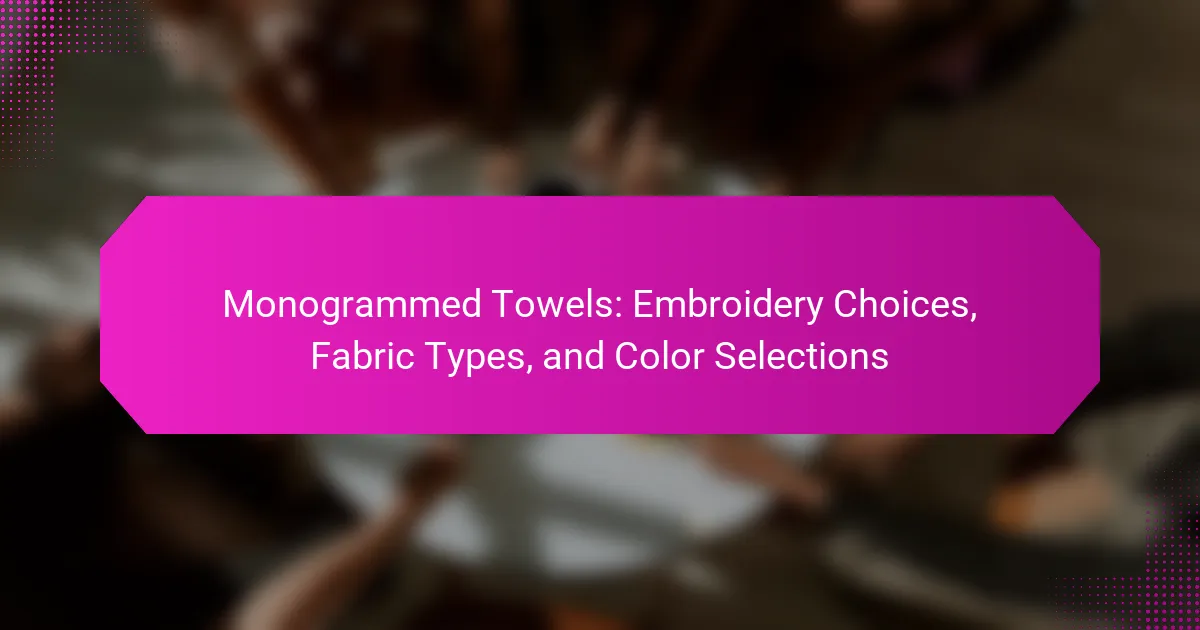Monogrammed towels are personalized towels featuring custom embroidery, typically of initials or names, which enhance their aesthetic appeal and make them easily identifiable. The article explores various embroidery choices, including fonts and colors, as well as the best fabric types, such as cotton and terry cloth, known for their durability and absorbency. It also discusses a wide range of color selections available for monogrammed towels, allowing for personalization to match individual preferences or home decor. These towels are popular for both personal use in homes and as thoughtful gifts for special occasions.
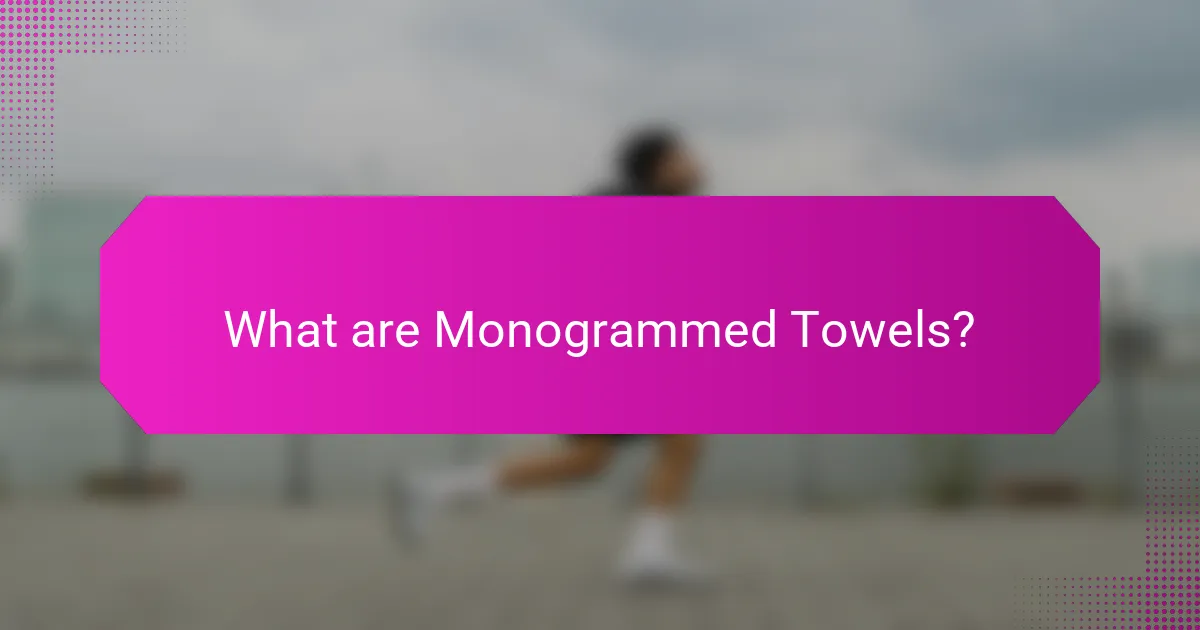
What are Monogrammed Towels?
Monogrammed towels are towels that feature personalized embroidery, typically consisting of initials or a name. This customization adds a unique touch to standard towels. Monogramming can enhance the aesthetic appeal and make towels easily identifiable. They are often used in homes, spas, and hotels for a luxurious feel. The embroidery can be done in various fonts and colors to match personal preferences. Monogrammed towels also make popular gifts for weddings and special occasions. Their personalized nature elevates the standard towel into a thoughtful and stylish item.
How are Monogrammed Towels different from regular towels?
Monogrammed towels differ from regular towels primarily through the personalized embroidery. This embroidery typically features initials or names, adding a unique touch. Regular towels lack this customization and are usually produced in standard designs. Monogrammed towels often use higher-quality materials to enhance their luxury appeal. Many consumers choose monogrammed options for gifting or home decor purposes. The personalization also makes them easier to identify in shared spaces. Overall, the key distinction lies in the added personalization and often superior craftsmanship.
What makes the personalization of towels significant?
Personalization of towels is significant because it adds a unique identity to the item. Customized towels enhance the user experience by providing a sense of ownership. They can reflect personal style or serve as thoughtful gifts. Monogramming allows for initials or names, making towels easily identifiable. This feature is particularly useful in shared spaces like gyms or pools. Personalized towels can also enhance branding for businesses in hospitality. They create a memorable impression on guests. Personalized items often hold sentimental value, increasing emotional attachment.
What are the common uses for Monogrammed Towels?
Monogrammed towels are commonly used for personalizing bath and hand towels. They serve as unique gifts for weddings, anniversaries, or housewarmings. Monogrammed towels are often utilized in spas and hotels to enhance branding and customer experience. They can also be used in homes to distinguish family members’ towels. Additionally, monogrammed towels are frequently used in sports settings, such as for team events or competitions. Their customization adds a touch of elegance to any setting, making them popular for special occasions.
What styles of Monogrammed Towels are available?
Available styles of monogrammed towels include classic, contemporary, and playful designs. Classic styles feature traditional fonts and elegant embroidery. Contemporary styles often use modern typography and minimalist designs. Playful designs may incorporate fun fonts and vibrant colors. Each style can be customized with various thread colors and placements. The choice of style depends on personal preference and intended use. Monogrammed towels can suit various occasions, from weddings to personal gifts.
What are the popular designs for monogramming?
Popular designs for monogramming include classic, script, block, and decorative styles. Classic monograms often feature initials in a traditional font. Script fonts provide an elegant and flowing appearance. Block designs are bold and easy to read. Decorative styles may incorporate flourishes or graphics. These designs are commonly used on towels, adding a personalized touch. They enhance the aesthetic appeal and make items distinctive. Monogramming is often chosen for weddings, gifts, and home décor. Each design has its unique charm and suitability for different occasions.
How do different styles affect the overall aesthetic?
Different styles significantly influence the overall aesthetic of monogrammed towels. Each style, such as classic, modern, or whimsical, brings a unique visual appeal. Classic styles often feature elegant fonts and traditional motifs, enhancing a timeless look. Modern styles tend to utilize minimalist designs and bold typography, creating a contemporary feel. Whimsical styles incorporate playful elements and vibrant colors, adding a fun and personalized touch. The choice of fabric also impacts aesthetic; plush fabrics convey luxury, while lighter materials suggest casual elegance. Overall, the combination of style, font, and fabric choice determines the towel’s visual impact and complements various interior designs.
Why choose Monogrammed Towels for gifting?
Monogrammed towels are an excellent gifting choice due to their personalized touch. Personalization adds sentimental value to the gift. Monogrammed items show thoughtfulness and consideration for the recipient. They can be customized with initials, names, or special dates. This customization makes the towels unique to the individual. Monogrammed towels are also practical and functional. High-quality towels provide utility in daily life. They are available in various fabric types and colors to suit different preferences. This versatility makes them suitable for various occasions, such as weddings, housewarmings, or holidays.
What occasions are ideal for gifting Monogrammed Towels?
Monogrammed towels are ideal for various gifting occasions. They make thoughtful gifts for weddings, as couples appreciate personalized items. Birthdays are another great occasion, allowing for a customized touch. Housewarming events benefit from monogrammed towels, adding a personal flair to new homes. Holidays like Christmas and Mother’s Day are perfect for gifting, showcasing care and affection. Additionally, they are suitable for spa days or self-care gifts, promoting relaxation. Each occasion highlights the uniqueness and personal connection of monogrammed towels.
How does personalization enhance the gifting experience?
Personalization enhances the gifting experience by creating a deeper emotional connection between the giver and recipient. Customized gifts, such as monogrammed towels, reflect thoughtfulness and consideration. They show that the giver has put effort into selecting something unique. Research indicates that personalized gifts are perceived as more valuable. A study by the Journal of Consumer Research found that personalization increases the recipient’s appreciation. This appreciation can lead to stronger relationships and lasting memories. Personalization also makes the gift more memorable, as it is tailored to the recipient’s preferences. Therefore, incorporating personalization into gifts significantly enriches the overall experience.
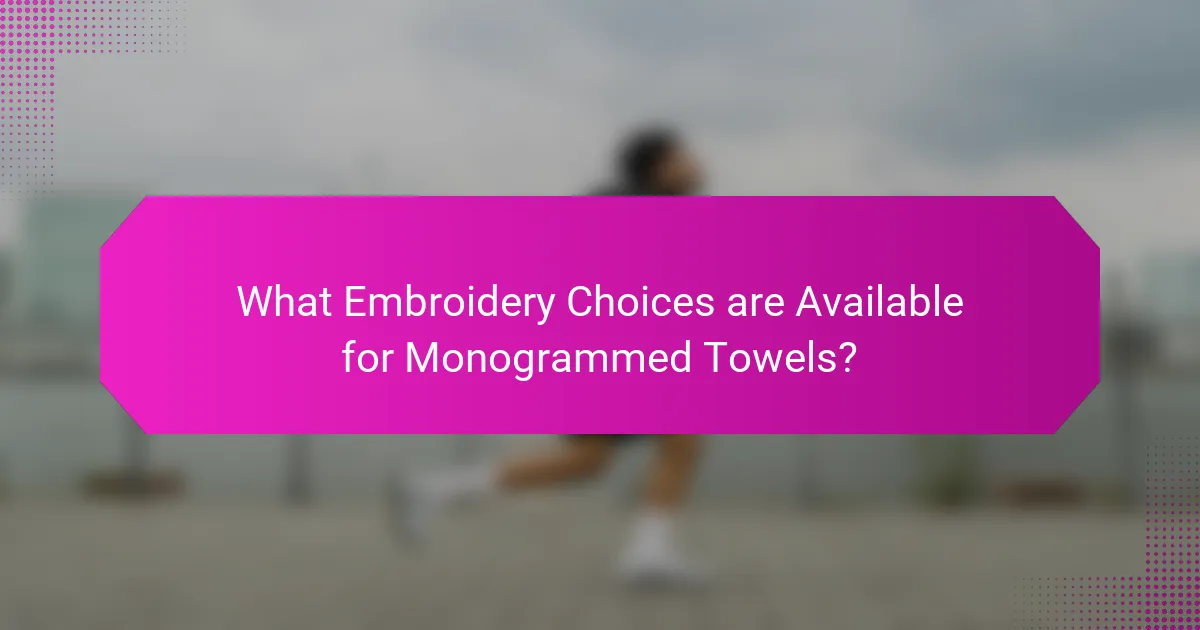
What Embroidery Choices are Available for Monogrammed Towels?
Monogrammed towels offer various embroidery choices. Common options include block letters, script fonts, and decorative designs. Each style can be customized in size and placement. Popular thread colors range from classic white to vibrant hues. Some towels feature intricate patterns or motifs alongside monograms. Personalized designs can also include initials or full names. Many services provide digital proofs before finalizing the embroidery. This ensures customer satisfaction with the chosen design.
What types of embroidery techniques can be used?
Various embroidery techniques can be used for monogrammed towels. Common techniques include satin stitch, which creates a smooth, shiny finish. Chain stitch offers a decorative outline effect. Cross-stitch provides a traditional, textured appearance. Appliqué involves sewing fabric shapes onto the towel for added dimension. Lastly, machine embroidery allows for intricate designs and faster production. Each technique enhances the aesthetic appeal of monogrammed towels, making them unique and personalized.
How does each embroidery technique affect the look and feel?
Each embroidery technique significantly influences the look and feel of the fabric. Techniques like satin stitch create a smooth, glossy finish, enhancing the visual appeal. In contrast, a chain stitch offers a textured, raised effect, which adds dimension to the design.
The look of a design can also be affected by the density of stitches. Dense stitching yields a bold appearance, while lighter stitching creates a more delicate, subtle look. Techniques such as appliqué can introduce contrasting fabrics, altering both the texture and the overall aesthetic.
Additionally, the choice of thread type impacts the feel. Metallic threads provide shine but may feel stiffer, while cotton threads yield a softer touch. The embroidery technique chosen determines not only the visual outcome but also how the fabric interacts with the skin.
Therefore, the selection of embroidery techniques is crucial for achieving desired aesthetics and tactile qualities in monogrammed towels.
What are the durability differences among embroidery techniques?
Durability differences among embroidery techniques vary significantly based on the method used. Machine embroidery generally offers greater durability than hand embroidery. This is due to the precision and consistency of machine stitching. Techniques like satin stitch provide a smooth finish but can fray over time. In contrast, fill stitch techniques are more robust and withstand wear better.
Embroidery methods such as appliqué can enhance durability by reinforcing fabric edges. However, they may require additional care to maintain their integrity. The choice of thread also impacts durability; polyester threads are typically stronger than cotton threads. Research indicates that the density of stitches influences durability as well, with higher stitch counts leading to more resilient designs.
How do font styles impact the design of Monogrammed Towels?
Font styles significantly influence the design of monogrammed towels. They determine the overall aesthetic and readability of the monogram. Different font styles convey various emotions and themes, affecting consumer perception. For instance, cursive fonts evoke elegance, while bold sans-serif fonts suggest modernity. The choice of font can enhance or detract from the towel’s design, impacting its appeal as a gift or decorative item. Additionally, font size and spacing influence how well the monogram stands out against the fabric. Research indicates that legible fonts improve recognition and personalization, which is crucial for monogrammed items.
What are the most popular font styles for monogramming?
The most popular font styles for monogramming include serif, sans-serif, script, and block fonts. Serif fonts, like Times New Roman, offer a classic and elegant look. Sans-serif fonts, such as Arial, provide a modern and clean appearance. Script fonts mimic handwriting and add a personal touch. Block fonts are bold and easy to read, making them a favorite for visibility. These styles are commonly chosen for their aesthetic appeal and readability in monogramming applications.
How does font choice reflect personal style?
Font choice reflects personal style by conveying individual preferences and aesthetic sensibilities. Different fonts evoke distinct emotions and associations. For instance, serif fonts often suggest tradition and reliability. In contrast, sans-serif fonts can appear modern and clean. Script fonts may reflect elegance and creativity. Personal style is often showcased through font selection in monogrammed items. Customized monograms can enhance the uniqueness of towels. Studies have shown that typography influences perceptions of personality traits. For example, a bold font may convey confidence, while a delicate font may suggest sophistication. Thus, the choice of font serves as a visual representation of personal identity.
What are the considerations for size and placement of monograms?
Monogram size and placement depend on the item’s dimensions and intended use. For towels, a common size for monograms is 3 to 5 inches in height. This size ensures visibility while maintaining an elegant appearance. Placement is typically centered on one end of the towel. Alternatively, monograms can be placed in a corner for a more subtle look.
Consideration of fabric type also influences placement. Thicker fabrics may require larger monograms for clarity. Conversely, delicate fabrics may benefit from smaller, more refined designs. The overall design aesthetic should align with the user’s preference, whether traditional or modern.
Personalization plays a key role in choosing size and placement. Many individuals prefer monograms that reflect their style or identity. Therefore, evaluating the specific context of use is crucial.
How does the size of the monogram affect visibility?
The size of the monogram directly influences its visibility. Larger monograms are more easily seen from a distance. They stand out against the fabric, enhancing readability. Conversely, smaller monograms may blend into the towel’s texture. This can make them harder to notice, especially in busy patterns. Studies show that text size affects legibility; larger sizes improve recognition rates. Visibility is crucial for branding and personalization in monogrammed items. Therefore, choosing an appropriate size is essential for effective display.
What are common placement options for monograms on towels?
Common placement options for monograms on towels include the bottom corner, center, and edge. The bottom corner is a popular choice for a subtle look. Center placement offers a bold and prominent display. Edge placement can create a stylish accent. These options allow for personalization while maintaining the towel’s functionality. Many choose placement based on the towel’s use, such as bath towels or hand towels. Each option enhances the aesthetic appeal of the towels.
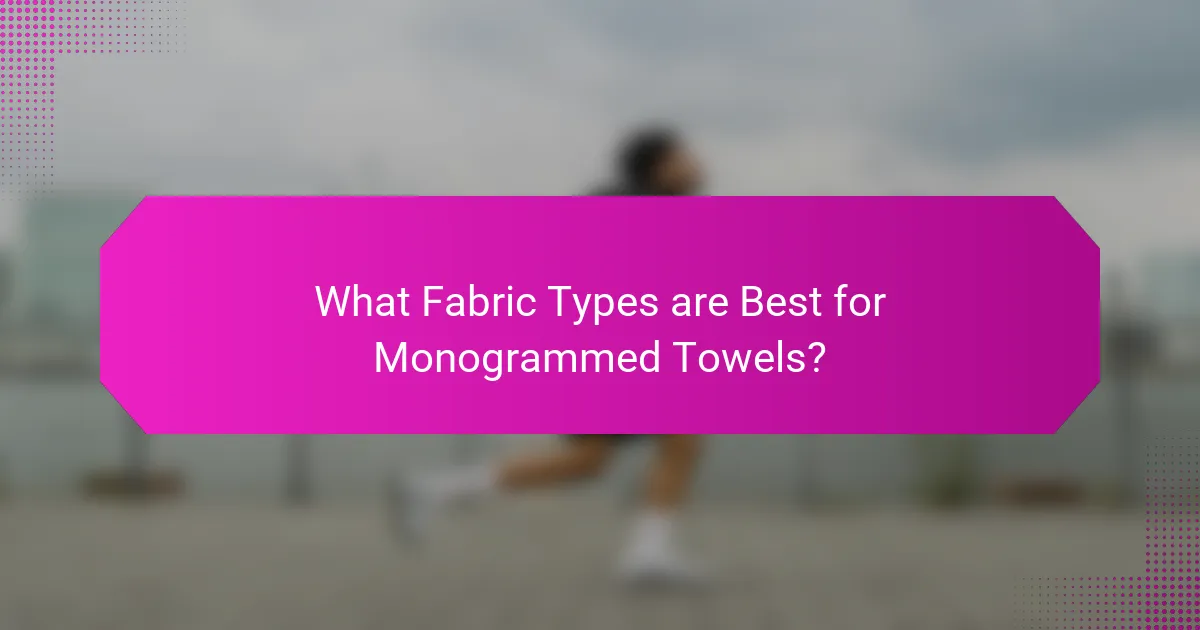
What Fabric Types are Best for Monogrammed Towels?
Cotton and terry cloth are the best fabric types for monogrammed towels. Cotton is soft, absorbent, and durable, making it ideal for everyday use. Terry cloth enhances absorbency due to its looped fibers, providing a plush feel. Both fabrics hold embroidery well, ensuring that monograms remain clear and vibrant. Additionally, cotton towels can withstand repeated washing without fading. Terry cloth’s thickness allows for deeper stitching, enhancing the overall aesthetic. These characteristics make cotton and terry cloth the preferred choices for high-quality monogrammed towels.
What are the most common fabrics used for towels?
The most common fabrics used for towels are cotton, microfiber, and bamboo. Cotton towels are popular due to their absorbency and softness. They are often made from long-staple cotton, which enhances durability. Microfiber towels are known for their quick-drying properties and lightweight nature. They are effective at absorbing moisture and are often used in sports towels. Bamboo towels are eco-friendly and possess natural antibacterial properties. They are soft and highly absorbent, making them a sustainable choice. Each fabric offers distinct advantages for different towel uses.
How do cotton and microfiber compare for towel quality?
Cotton towels generally offer superior absorbency compared to microfiber towels. Cotton fibers can absorb up to 25 times their weight in water, making them ideal for drying. Microfiber towels, while lightweight and quick-drying, do not absorb as much moisture as cotton.
Cotton towels are soft and provide a plush feel, enhancing comfort during use. Microfiber towels are smoother and can feel less luxurious but are often more durable.
Cotton is more prone to wear and tear over time, while microfiber tends to maintain its structure longer. However, cotton towels can be more prone to shrinking and fading after multiple washes.
Microfiber towels are typically less expensive and can be machine washed without special care, while cotton towels may require more careful washing to preserve quality.
What are the benefits of using bamboo fabric for towels?
Bamboo fabric offers several benefits for towels. It is highly absorbent, often outperforming cotton in moisture retention. Bamboo towels can absorb up to three times their weight in water. The fabric is also naturally antibacterial, reducing the growth of odor-causing bacteria. This property helps maintain freshness over time. Additionally, bamboo fabric is soft and gentle on the skin, providing a luxurious feel. The material is eco-friendly, as bamboo grows quickly and requires less water compared to traditional crops. Lastly, bamboo towels are biodegradable, making them a sustainable choice for consumers.
How does fabric type affect the embroidery process?
Fabric type significantly influences the embroidery process. Different fabrics have varying levels of thickness, texture, and stretch. For instance, cotton is generally easy to embroider due to its stability and smooth surface. In contrast, fabrics like silk may require special care to prevent puckering during stitching.
The choice of fabric also affects needle type and thread tension. Heavier fabrics may need larger needles and increased tension to ensure clean stitching. Conversely, lighter fabrics require finer needles to avoid damage.
Additionally, the fabric’s weave impacts the embroidery’s appearance. Looser weaves may allow for more thread visibility, while tighter weaves can create a more polished finish.
Using the correct stabilizer is crucial based on fabric type. For example, knit fabrics often need a cut-away stabilizer to maintain design integrity. This adaptability in approach is essential for achieving high-quality embroidery results.
What fabrics are best suited for detailed embroidery?
Cotton and linen are the best fabrics suited for detailed embroidery. These materials provide a stable surface for intricate stitching. Cotton has a smooth texture that allows for precise needlework. Linen is known for its durability and ability to hold designs well. Both fabrics are widely used in monogrammed towels. They can withstand the tension of embroidery threads without distortion. Additionally, cotton and linen absorb dye effectively, enhancing color vibrancy in designs. Their natural fibers also reduce fraying, ensuring longevity of embroidered patterns.
How do different fabrics impact the longevity of the embroidery?
Different fabrics significantly impact the longevity of embroidery. Natural fibers like cotton tend to hold embroidery well due to their durability and strength. Synthetic fabrics such as polyester also offer good longevity but may require specific threads to prevent fraying. Fabrics with a tight weave provide a stable base, which enhances the lifespan of the embroidery. Conversely, loosely woven fabrics can lead to distortion and wear over time. Additionally, the weight of the fabric influences how well the embroidery withstands washing and use. Research shows that embroidery on high-thread-count fabrics lasts longer due to reduced stress on stitches. Therefore, choosing the right fabric is crucial for ensuring the durability of embroidered designs.
What factors should be considered when choosing fabric for Monogrammed Towels?
When choosing fabric for monogrammed towels, consider absorbency, durability, and softness. Absorbency is crucial as towels need to efficiently soak up water. Cotton is a popular choice due to its high absorbency levels. Durability ensures the towel withstands frequent use and washing. Fabrics like terry cloth and Egyptian cotton are known for their strength. Softness contributes to the overall comfort of the towel. Fabrics like microfiber offer a plush feel. Additionally, consider the fabric weight, which affects the towel’s thickness and plushness. Heavier fabrics generally provide more warmth and absorbency. Finally, colorfastness is important to ensure that the fabric maintains its color after washing.
How do absorbency and softness influence fabric choice?
Absorbency and softness are critical factors in fabric choice for towels. High absorbency ensures that towels can efficiently soak up water, which is essential for drying. Fabrics like cotton have natural absorbent properties, making them a popular choice for towels. Softness enhances comfort, providing a pleasant feel against the skin. Soft fabrics are often preferred for personal use, such as bath towels.
Research indicates that towels with higher cotton content tend to be softer and more absorbent. According to a study published in the Journal of Textile Science, towels made from 100% cotton absorb up to 25% more water than synthetic alternatives. Therefore, when selecting towels, both absorbency and softness significantly influence the overall user experience.
What is the importance of weight and thickness in towel selection?
Weight and thickness are crucial factors in towel selection. They determine absorbency, durability, and comfort. Heavier towels typically absorb more water due to increased fabric density. For example, towels weighing 600 grams per square meter (GSM) are often considered high-quality for their superior absorbency. Thicker towels provide a plush feel, enhancing user experience. Conversely, lighter towels dry faster and are more portable, making them suitable for travel. Selecting the right weight and thickness ensures that towels meet specific needs, whether for everyday use or luxury experiences.
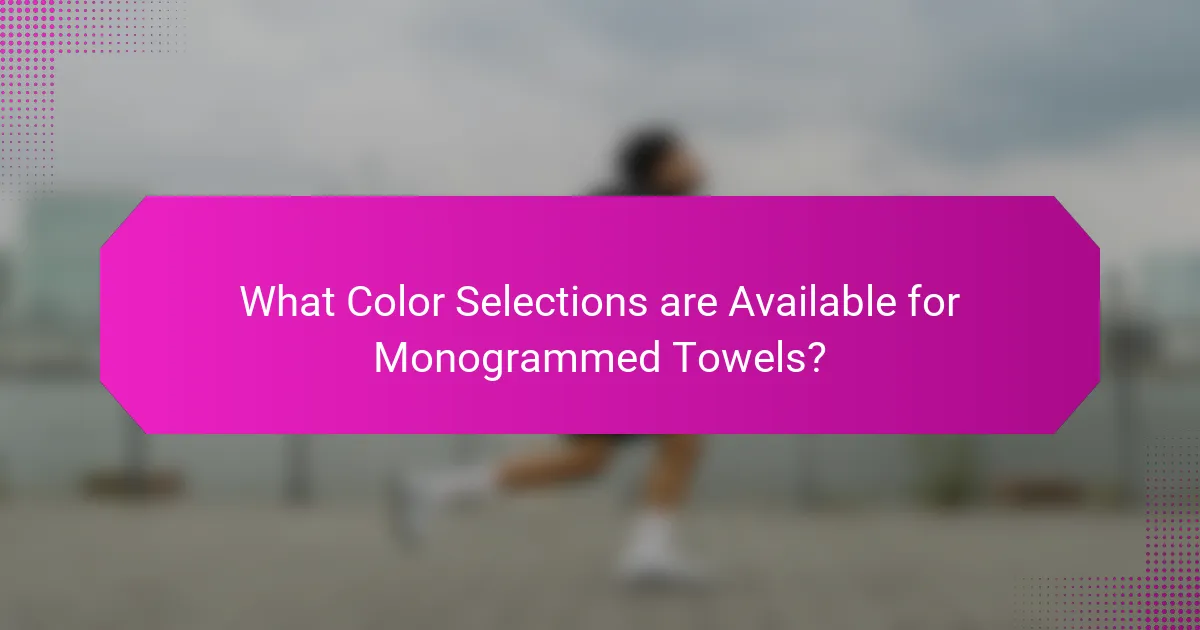
What Color Selections are Available for Monogrammed Towels?
Monogrammed towels are available in a variety of color selections. Common colors include white, cream, navy blue, and pastel shades like pink or mint green. Many manufacturers also offer vibrant colors such as red, royal blue, and charcoal gray. Custom color options may be available depending on the retailer. These choices allow for personalization to match home decor or individual preferences. The wide range of colors ensures that there is a suitable option for everyone.
What are the trending colors for Monogrammed Towels?
Trending colors for monogrammed towels include soft pastels, vibrant jewel tones, and neutral shades. Soft pastels like blush pink and baby blue are popular for their calming appeal. Vibrant jewel tones such as emerald green and royal blue add a touch of luxury. Neutral shades like beige and gray remain timeless and versatile. These colors are favored for their ability to complement various bathroom decor styles. According to industry reports, these color trends reflect a growing preference for personalized and stylish home accessories.
How do seasonal trends influence color choices?
Seasonal trends significantly influence color choices in various products, including monogrammed towels. Each season brings distinct color palettes that resonate with consumer emotions and preferences. For instance, spring often features pastel shades, reflecting renewal and freshness. Summer typically embraces vibrant and bold colors, symbolizing energy and warmth. Autumn favors earthy tones, evoking feelings of coziness and comfort. Winter usually highlights deep, rich hues, aligning with festive themes.
Fashion and design industries closely monitor these seasonal trends to guide their color selections. Research indicates that 80% of consumers are influenced by seasonal color palettes when making purchases. This connection between seasons and color choices is evident in marketing strategies and product designs. Brands that align their offerings with seasonal trends often experience increased consumer engagement and sales.
What colors work best for different occasions?
For different occasions, specific colors evoke distinct feelings and themes. For weddings, soft pastels like blush and lavender create a romantic atmosphere. For corporate events, navy and gray convey professionalism and reliability. For casual gatherings, bright colors like yellow and orange promote a cheerful vibe. For funerals, muted tones like black and dark blue symbolize respect and mourning. For holidays, festive colors like red and green enhance celebratory moods. These color choices align with cultural associations and psychological impacts, making them suitable for their respective occasions.
How does color choice affect the overall design of Monogrammed Towels?
Color choice significantly influences the overall design of monogrammed towels. It affects aesthetic appeal and personalization. Specific colors can evoke emotions and set a tone. For instance, soft pastels create a calming effect, while vibrant hues energize a space. The contrast between the towel color and the monogram enhances visibility. A well-chosen color scheme can align with interior decor trends. Color also plays a role in branding for businesses using monogrammed towels. Research shows that color can increase brand recognition by up to 80%. Therefore, selecting the right colors is crucial for effective design in monogrammed towels.
What are the best color combinations for monogramming?
The best color combinations for monogramming include classic pairings like navy blue and white, or black and gold. These combinations offer a timeless appeal and high contrast, ensuring visibility. Other popular choices are pastel shades like soft pink and mint green for a more delicate look. Bold colors such as red and white can create a striking visual effect. Monogramming often utilizes colors that complement the fabric of the item being embroidered. For instance, light-colored towels look great with dark thread colors. According to design experts, choosing colors that reflect personal style enhances the overall aesthetic of the monogram.
How does the color of the towel impact the visibility of the monogram?
The color of the towel significantly impacts the visibility of the monogram. A high-contrast color combination enhances visibility. For example, a white monogram on a navy towel stands out clearly. Conversely, a monogram in a similar shade to the towel’s color can be hard to see. Research indicates that contrast improves readability in textiles. Studies show that color contrast affects visual perception. Proper color selection is essential for effective monogram visibility.
What tips can help in selecting the right color for Monogrammed Towels?
Choose a color that complements your bathroom decor. Consider the existing color scheme of your space. Neutral colors like white or beige are versatile. Bright colors can add a pop of personality. Think about the recipient’s preferences if gifting. Test color swatches in natural light for true representation. Ensure the monogram color contrasts well with the towel color for visibility. Consider seasonal colors for a fresh look throughout the year.
How can personal style guide color selection?
Personal style guide color selection can enhance the overall aesthetic of monogrammed towels. A well-chosen color palette reflects individual preferences and complements the design. Colors can evoke emotions and set the tone for a space. For instance, soft pastels create a calming effect, while bold hues add vibrancy. Additionally, contrasting colors can make monograms stand out. According to color theory, colors can influence perception and mood. Selecting colors that harmonize with existing decor ensures visual coherence. Therefore, personal style guide color selection is essential for creating appealing and personalized monogrammed towels.
What are common mistakes to avoid when choosing colors?
Common mistakes to avoid when choosing colors include not considering the color wheel. Ignoring color harmony can lead to clashing combinations. Failing to test colors in the actual environment may result in unexpected outcomes. Not accounting for fabric type can affect how colors appear. Overlooking the significance of lighting can alter color perception. Choosing trendy colors without considering longevity may lead to quick obsolescence. Neglecting personal preference can result in dissatisfaction with the final product. Lastly, not seeking professional advice can lead to uninformed decisions.
Monogrammed towels are personalized towels featuring custom embroidery, typically initials or names, enhancing their aesthetic appeal and functionality. This article covers the differences between monogrammed and regular towels, the significance of personalization, common uses, available styles and designs, and the impact of fabric types on the embroidery process. It also discusses color selections, trending colors, and tips for choosing the right colors to ensure visibility and alignment with personal style. Additionally, the article explores the durability of various embroidery techniques and the considerations for size and placement of monograms.
